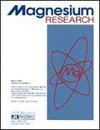急性心肌梗死的严重程度、并发症和死亡率与通过饮用脱盐海水摄入镁不足有关。
IF 1
4区 医学
Q4 BIOCHEMISTRY & MOLECULAR BIOLOGY
引用次数: 3
摘要
饮用水(DW)是镁的重要膳食来源。以色列最近增加了用于海水淡化的海水淡化剂(DSW)的生产,但DSW中微不足道的镁含量可能造成低镁血症和随之而来的心血管不良影响。2015-2017年住院st段抬高型心肌梗死(STEMI)的连续急性心肌梗死(AMI)患者(n = 380,年龄35-75岁),根据居住地区是否有DSW主要供应(n = 250, 65%)分为两组(非DSW;N = 130, 35%)。我们评估了入院患者的血清镁浓度、自来水中的镁水平、1年全因死亡率和主要心血管不良事件(MACE),包括全因死亡率、非致死性心肌梗死、心力衰竭或心绞痛再住院、中风、冠状动脉旁路移植术和经皮冠状动脉介入治疗。多变量分析根据年龄和性别进行了调整。非DSW组患者血清镁浓度(平均±SD)显著高于DSW组(1.95±0.20 mg/dL和1.81±0.20 mg/dL, P < 0.001;分别)。此外,DSW组的平均居住DW镁水平为5.4±2.2 mg/L,而非DSW组为25.1±3.4 mg/L, P < 0.01。与DSW组相比,非DSW组出现重大不良心血管事件(MACE)或1年全因死亡率的患者较少(尽管无统计学意义)(12.4%和20%,P = 0.065;分别)。总之,在AMI后患者中,我们发现使用DSW后MACE和1年死亡率无显著升高。本文章由计算机程序翻译,如有差异,请以英文原文为准。
Acute myocardial infarction severity, complications, and mortality associated with lack of magnesium intake through consumption of desalinated seawater.
Drinking water (DW) is an important dietary source of magnesium. Israel has recently increased desalinated seawater (DSW) production for DW, but negligible magnesium content in DSW may pose a risk of hypomagnesemia and consequential adverse cardiovascular effects. Consecutive acute myocardial infarction (AMI) patients (n = 380, age 35-75 years), hospitalized in 2015-2017 with ST-segment elevation myocardial infarction (STEMI), were divided into two groups based on their domicile region having a major supply of DSW (n = 250, 65%) or not (non-DSW; n = 130, 35%). We evaluated admission serum magnesium concentrations in patients, magnesium levels in tap water, 1-year all-cause mortality, and major adverse cardiovascular events (MACE), including all-cause mortality, nonfatal myocardial infarction, rehospitalization for heart failure or angina pectoris, stroke, coronary artery bypass grafting, and percutaneous coronary interventions. Multivariate analyses were adjusted for age and sex. Serum magnesium concentrations (mean ± SD) were significantly higher among patients in the non-DSW group compared with the DSW group (1.95 ± 0.20 mg/dL and 1.81 ± 0.20 mg/dL, P < 0.001; respectively). Additionally, the mean residential DW magnesium level in the DSW group was 5.4 ± 2.2 mg/L compared with 25.1 ± 3.4 mg/L, P < 0.01 in the non-DSW group. Fewer patients (although not statistically significant) in the non-DSW group experienced major adverse cardiovascular events (MACE) or 1-year-all-cause mortality compared with the patients in the DSW group (12.4% and 20%, P = 0.065; respectively). In conclusion, in post AMI patients, we found nonsignificant higher MACE and 1-year mortality with the use of DSW.
求助全文
通过发布文献求助,成功后即可免费获取论文全文。
去求助
来源期刊

Magnesium research
医学-内分泌学与代谢
CiteScore
3.50
自引率
9.40%
发文量
6
审稿时长
>12 weeks
期刊介绍:
Magnesium Research, the official journal of the international Society for the Development of Research on Magnesium (SDRM), has been the benchmark journal on the use of magnesium in biomedicine for more than 30 years.
This quarterly publication provides regular updates on multinational and multidisciplinary research into magnesium, bringing together original experimental and clinical articles, correspondence, Letters to the Editor, comments on latest news, general features, summaries of relevant articles from other journals, and reports and statements from national and international conferences and symposiums.
Indexed in the leading medical databases, Magnesium Research is an essential journal for specialists and general practitioners, for basic and clinical researchers, for practising doctors and academics.
 求助内容:
求助内容: 应助结果提醒方式:
应助结果提醒方式:


